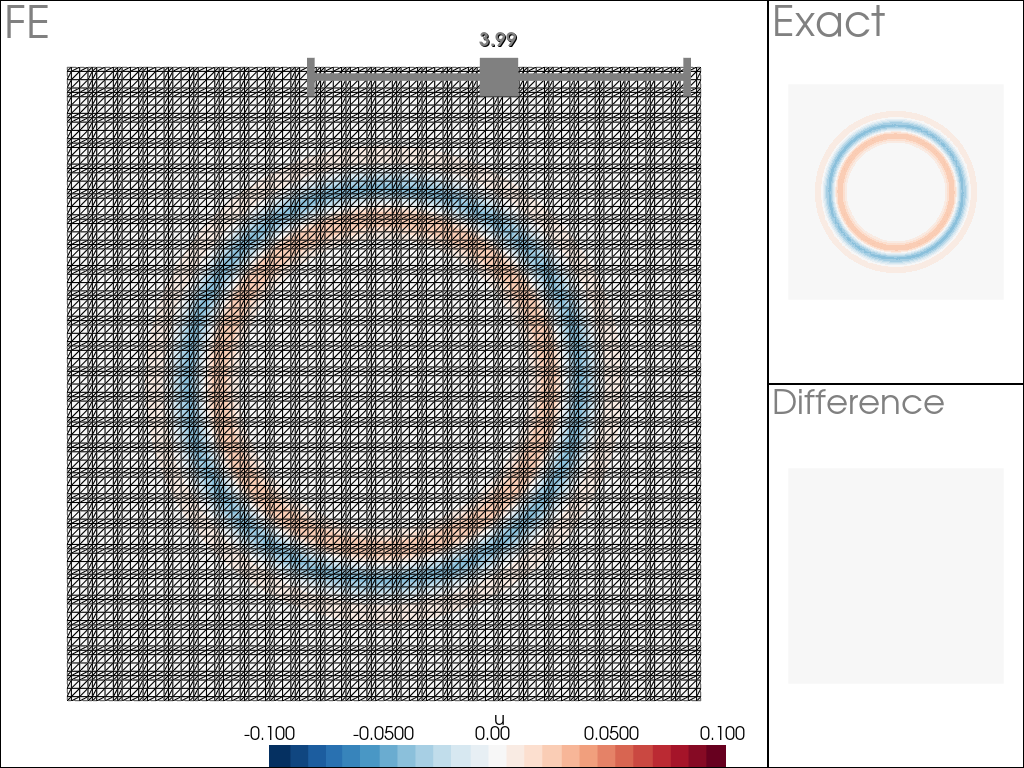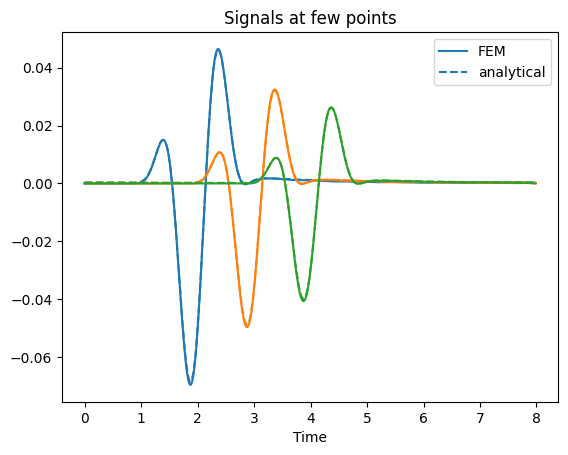Shear Horizontal (SH) elastic waves in an unbounded solid
Time-domain, explicit scheme, Spectral elements
2D
Scalar medium
Impedance absorbing boundary conditions
Comparison with an analytical solution
[1]:
import numpy as np
import matplotlib.pyplot as plt
from dolfinx import mesh, fem, default_scalar_type
import ufl
from mpi4py import MPI
from petsc4py import PETSc
from elastodynamicsx.pde import material, BodyForce, boundarycondition, PDE, PDECONFIG
from elastodynamicsx.solvers import TimeStepper
from elastodynamicsx.plot import plotter
from elastodynamicsx.utils import spectral_element, spectral_quadrature, make_facet_tags, ParallelEvaluator
from analyticalsolutions import u_2D_SH_rt, int_Fraunhofer_2D
Set up a Spectral Element Method
[2]:
degElement, nameElement = 4, "GLL"
PDECONFIG.default_metadata = spectral_quadrature(nameElement, degElement)
cell_type = mesh.CellType.quadrilateral
specFE = spectral_element(nameElement, cell_type, degElement)
FE domain
[3]:
length, height = 10, 10
Nx, Ny = 100 // degElement, 100 // degElement # Nb of elts.
# create the mesh
extent = [[0., 0.], [length, height]]
domain = mesh.create_rectangle(MPI.COMM_WORLD, extent, [Nx, Ny], cell_type)
# create the function space
V = fem.functionspace(domain, specFE)
# define some tags
tag_left, tag_top, tag_right, tag_bottom = 1, 2, 3, 4
all_tags = (tag_left, tag_top, tag_right, tag_bottom)
boundaries = [(tag_left , lambda x: np.isclose(x[0], 0 )),
(tag_right , lambda x: np.isclose(x[0], length)),
(tag_bottom, lambda x: np.isclose(x[1], 0 )),
(tag_top , lambda x: np.isclose(x[1], height))]
facet_tags = make_facet_tags(domain, boundaries)
Define the material law
scalar law
-> fluid, or 2D Shear Horizontal polarization
[4]:
# parameters here...
rho = fem.Constant(domain, default_scalar_type(1))
mu = fem.Constant(domain, default_scalar_type(1))
# ... end
mat = material(V, 'scalar', rho, mu)
Boundary conditions
Plane-wave absorbing boundary conditions (‘Dashpot’)
\(\sigma(u).n = Z \partial_t u\) where \(Z=\rho c\) is the acoustic impedance of the medium
[5]:
Z = mat.Z # mechanical impedance
bc_l = boundarycondition((V, facet_tags, tag_left ), 'Dashpot', Z)
bc_r = boundarycondition((V, facet_tags, tag_right ), 'Dashpot', Z)
bc_b = boundarycondition((V, facet_tags, tag_bottom), 'Dashpot', Z)
bc_t = boundarycondition((V, facet_tags, tag_top ), 'Dashpot', Z)
bcs = [bc_l, bc_r, bc_b, bc_t]
Source term (body force)
[6]:
# ## -> Space function
X0_src = np.array([length / 2, height / 2, 0]) # Center
R0_src = 0.1 # Radius
# Gaussian function
nrm = 1 / (2 * np.pi * R0_src**2) # normalize to int[src_x(x) dx]=1
def src_x(x): # source(x): Gaussian
r = np.linalg.norm(x - X0_src[:, np.newaxis], axis=0)
return nrm * np.exp(-1/2 * (r / R0_src)**2, dtype=default_scalar_type)
# ## -> Time function
f0 = 1 # central frequency of the source
T0 = 1 / f0 # period
d0 = 2 * T0 # duration of source
def src_t(t): # source(t): Sine x Hann window
window = np.sin(np.pi * t / d0)**2 * (t < d0) * (t > 0) # Hann window
return np.sin(2 * np.pi * f0 * t) * window
# ## -> Space-Time function
F_0 = 1 # Amplitude of the source
def F_body_function(t): # source(x) at a given time
return lambda x: F_0 * src_t(t) * src_x(x)
# ## Body force 'F_body'
F_body = fem.Function(V) # body force
gaussianBF = BodyForce(V, F_body)
Assemble the PDE
[7]:
pde = PDE(V, materials=[mat], bodyforces=[gaussianBF], bcs=bcs)
Time scheme
[8]:
# Temporal parameters
tstart = 0 # Start time
tmax = 4 * d0 # Final time
num_steps = 500
dt = (tmax - tstart) / num_steps # time step size
# Some control numbers...
hx = length / Nx
c_SH = np.sqrt(mu.value / rho.value) # phase velocity
lbda0 = c_SH / f0
courant_number = TimeStepper.Courant_number(V.mesh, ufl.sqrt(mu / rho), dt)
PETSc.Sys.Print(f'Number of points per wavelength at central frequency: {lbda0 / hx:.2f}')
PETSc.Sys.Print(f'Number of time steps per period at central frequency: {T0 / dt:.2f}')
PETSc.Sys.Print(f'CFL condition: Courant number = {courant_number:.2f}')
# Time integration: define a TimeStepper instance
# diagonal=True assumes the left hand side operator is indeed diagonal
tStepper = TimeStepper.build(V,
pde.M_fn, pde.C_fn, pde.K_fn, pde.b_fn, dt, bcs=bcs,
scheme='leapfrog', diagonal=True)
# Set the initial values
tStepper.set_initial_condition(u0=0, v0=0, t0=tstart)
Number of points per wavelength at central frequency: 2.50
Number of time steps per period at central frequency: 62.50
CFL condition: Courant number = 0.04
Define outputs
Extract signals at few points
Live-plot results (only in a terminal; not in a notebook)
[9]:
u_res = tStepper.timescheme.u # The solution
# -> Store all time steps ? -> YES if debug & learning // NO if big calc.
storeAllSteps = True and domain.comm.size == 1 # WARNING: BUG IN PARALLEL: rank==0 does not return if storeAllSteps==True
all_u = [fem.Function(V) for i in range(num_steps)] if storeAllSteps else None # all steps are stored here
# -> Extract signals at few points
# Define points
points_out = X0_src[:, np.newaxis] + np.array([[1, 0, 0], [2, 0, 0], [3, 0, 0]]).T
# Declare a convenience ParallelEvaluator
paraEval = ParallelEvaluator(domain, points_out)
# Declare data (local)
signals_local = np.zeros((paraEval.nb_points_local,
1,
num_steps)) # <- output stored here
# -> Define callbacks: will be called at the end of each iteration
def cbck_storeFullField(i, out):
if storeAllSteps:
all_u[i+1].x.petsc_vec.setArray(out)
def cbck_storeAtPoints(i, out):
if paraEval.nb_points_local > 0:
signals_local[:, :, i+1] = u_res.eval(paraEval.points_local, paraEval.cells_local)
# -> enable live plotting
clim = 0.1 * F_0 * np.array([-1, 1])
if domain.comm.rank == 0:
p = plotter(u_res, refresh_step=10, **{'clim': clim})
if paraEval.nb_points_local > 0:
# add points to live_plotter
p.add_points(paraEval.points_local, render_points_as_spheres=True, point_size=12)
if p.off_screen:
p.window_size = [640, 480]
p.open_movie('weq_2D-SH_FullSpace.mp4')
else:
p = None
Solve
Define a ‘callfirst’ function to update the load
Run the time loop
[10]:
# 'callfirsts': will be called at the beginning of each iteration
def cfst_updateSources(t):
F_body.interpolate(F_body_function(t))
# Run the big time loop!
tStepper.solve(num_steps - 1,
callfirsts=[cfst_updateSources],
callbacks=[cbck_storeFullField, cbck_storeAtPoints],
live_plotter=p)
# End of big calc.
Post-processing
Interactive view of all time steps if stored -> Plotter with a slider to browse through all time steps
Plot signals at few points
[11]:
if storeAllSteps and domain.comm.rank == 0:
# Account for the size of the source in the analytical formula
fn_kdomain_finite_size = int_Fraunhofer_2D['gaussian'](R0_src)
# -> Exact solution, Full field
x = u_res.function_space.tabulate_dof_coordinates()
r = np.linalg.norm(x - X0_src[np.newaxis, :], axis=1)
t = dt * np.arange(num_steps)
all_u_n_exact = u_2D_SH_rt(r, src_t(t), rho.value, mu.value, dt, fn_kdomain_finite_size)
def update_fields_function(i):
return (all_u[i].x.array, all_u_n_exact[:, i], all_u[i].x.array - all_u_n_exact[:, i])
# Initializes with empty fem.Function(V) to have different valid pointers
p = plotter(fem.Function(V), fem.Function(V), fem.Function(V), labels=('FE', 'Exact', 'Difference'), clim=clim)
p.add_time_browser(update_fields_function, t)
p.show()

[12]:
# Gather the data to the root process
all_signals = paraEval.gather(signals_local, root=0)
if domain.comm.rank == 0:
# Account for the size of the source in the analytical formula
fn_kdomain_finite_size = int_Fraunhofer_2D['gaussian'](R0_src)
# -> Exact solution, At few points
x = points_out.T
r = np.linalg.norm(x - X0_src[np.newaxis, :], axis=1)
t = dt * np.arange(num_steps)
signals_exact = u_2D_SH_rt(r, src_t(t), rho.value, mu.value, dt, fn_kdomain_finite_size)
#
fig, ax = plt.subplots(1, 1)
ax.set_title('Signals at few points')
for i in range(len(all_signals)):
ax.plot(t, all_signals[i, 0, :], c=f'C{i}', ls='-')
ax.plot(t, signals_exact[i, :], c=f'C{i}', ls='--')
ax.set_xlabel('Time')
ax.legend(['FEM', 'analytical'])
plt.show()
